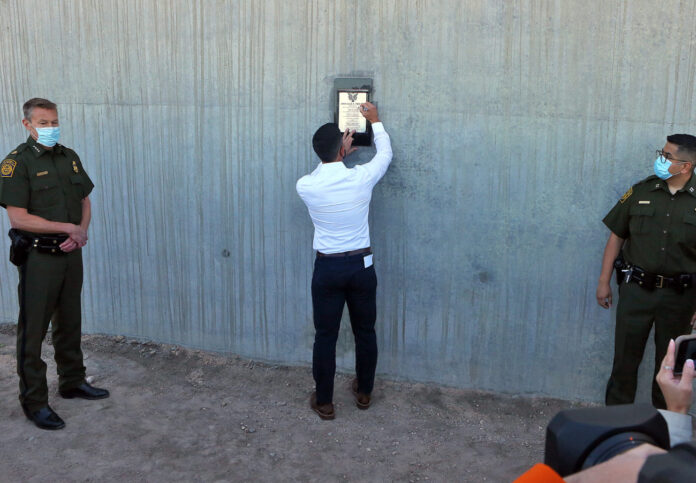
A U.S. flag billowed in the cold, Thursday morning breeze as it hung from a construction crane propped up close to border fencing near the Rio Grande in McAllen. It served as a backdrop for the visit of top Department of Homeland Security officials, including Acting Secretary Chad Wolf.
They gathered in the Valley to mark the completion of 400 miles of border wall fencing under President Donald Trump just five days before Election Day. Critics question the timing and whether visits like this are in violation of the Hatch Act, a law prohibiting political activities of federal employees.
“I dismiss that, obviously,” Wolf said when asked if the event was electioneering.
He said it was “absurd” to consider that the department can’t talk about their accomplishments, and said this wasn’t the only trip he’d made to the Valley for similar reasons. Wolf toured the same structure in 2019.
The construction of the wall was a centerpiece to the changes proposed in 2016 by then presidential candidate, Donald Trump. While some were skeptical of the ability to reinforce and add fencing along the border during his term, Wolf emphasized the achievement ending his remarks saying, “promises made, promises kept.”
Trump’s promise was two-fold — construction of a border wall and the outsourcing of its financial burden. “Mexico will pay for it,” Trump said repeatedly during rallies and at the beginning of his term in office.
Instead, over $12 billion was allocated from “a combination of appropriations, the Treasury Forfeiture Fund and in reprogrammed funds from the Department of Defense,” according to a July report from the Office of Inspector General.
Federal law enforcement agencies weigh the costs against the effects of the fencing.
Apprehensions of people crossing through the ports of entry illegally flipped from 2019 into 2020. The wide implementation of policies like the Migrant Protection Protocols, which sends asylum seekers back to Mexico to await their U.S. court hearings, had a significant impact on those figures.
Once COVID-19 became a pandemic, another policy would further curtail the immigration flow.
In late March the Centers for Disease Control and Prevention announced an order suspending the right to allow people to enter the country from “countries where quarantinable communicable disease exists.”
It’s known by CBP as Title 42. Under that order, they’ve expelled people from the country without processing them as before.

However, even during a pandemic and newly created or renovated border wall structures, the number of people detained by Border Patrol is on the rise, both in Title 42 expulsions and general apprehensions.

U.S. Border Patrol Chief Rodney Scott said they are encountering a different demographic than in 2019, when thousands of immigrant families were seen turning themselves in to agents.
“Right now, the vast majority of the people we’re arresting coming across the border are adult, single Mexicans,” Scott said. “That’s a different demographic that’s much more committed, so we’re seeing recidivist rates.”
Where people were coming in was a factor considered when DHS officials recommended the creation of wall structures.
CBP Commissioner Mark Morgan said they consulted the Border Security Implementation Plan, or BSIP, and then requested input from chief patrol agents. He said based on that input, they do an analysis to determine the wall’s various locations.
“That’s where we originally came up with the 450 miles that we needed strategic locations at that time,” Morgan said.
Border Patrol’s input and cooperation with CBP was critiqued by the OIG. The agencies analyzed compiled data and created a ranking system of the zones patrolled by Border Patrol. Then, they “ranked them 1 through 33 in priority for border wall construction,” according to the report.
DHS didn’t go by rankings. OIG investigators found they “adjusted the rankings without documenting its rationale for prioritizing certain lower scoring southern border locations over those that the decision support tool had scored higher for investment.”
On Thursday, Chief Scott offered an explanation for that decision.

“We elected to go ahead and shift down to a lower priority, because I can make a difference there,” he said, adding, “and then take those human resources, agents and technology, and shift them into another area where I was going to have more challenges of building a wall.”
Commissioner Morgan said the Valley was where the bulk of immigration shifted from Tucson years ago. Immigration, he stressed, is fluid.
“With each mile the wall system that goes in place, with each new technology that we have that’s implemented and goes in place, that threat and those priorities change as the cartels change,” Morgan said.
The walls they’ve turned to as a solution to the fluid situation of immigration are expected to last “30 to 50 years,” according to the official present from the U.S. Army Corps of Engineers.
Each mile cost about $20.5 million to construct, according to Wolf’s estimates. That doesn’t include maintenance costs. Fifty more miles are expected to be completed by the end of the year.





